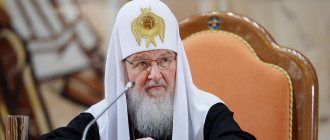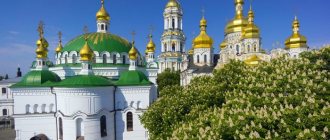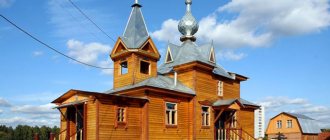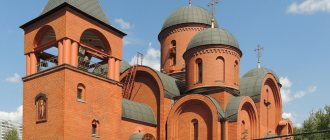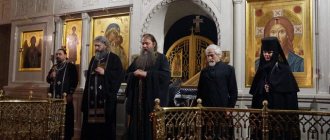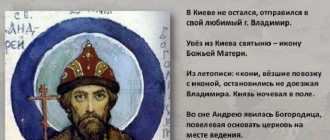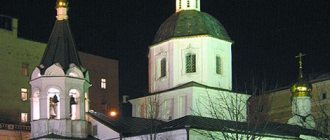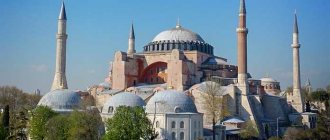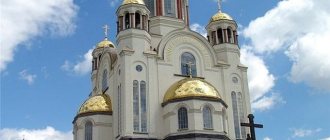In the north of Moscow they are going to build another temple - one of 380 provided for by the sensational program of building churches throughout the city. The appropriateness of the new temple raises questions among local residents, and its architectural merits among experts. However, all this does not bother the chief architect of Moscow, Sergei Kuznetsov, who, despite everything, approved its appearance. Passions for construction - in the material "Lenta.ru".
They started talking about the construction of a Temple in honor of the Holy Equal-to-the-Apostles Grand Duke Vladimir in the Pokrovskoye-Streshnevo area (many people call it Tushin due to the proximity of the metro station of the same name) in 2014.
Together with the Otkritie Arena, home to the football team Spartak, it should become part of the large multifunctional quarter “Tushino-2018” - with residential buildings, shopping centers and sports complexes. The construction company is responsible for the project; its co-owner is the brother of the owner of the football club, as well as the vice-president and major shareholder of Lukoil, Leonid Fedun, Andrey.
The temple is part of the “Program 200”, which was launched back in 2010. Initially, it provided for the construction of 200 new churches in Moscow. After the annexation of new territories to the capital, their total number increased to 380. Despite the fact that the project was launched back in the Luzhkov era, it is actively supported by the current chief architect of the city, Sergei Kuznetsov: “We were taught at the institute that the church is the most important architectural structure.” “, he said, commenting on the construction of the temple in the Pokrovskoye-Streshnevo area.
Meanwhile, many experts doubt the need for another religious building in the city. In its vicinity there are already at least five churches, and local believers hardly have a shortage of them.
By the way, soon after they started talking about the construction of hundreds of new churches, it turned out that residents of residential areas (construction almost did not affect the city center, where there were historically many churches) were not happy with the new neighborhood. Some complained about the cutting down of parks or the proximity of churches to residential buildings, while others did not like the dominance of religious buildings in the capital and the aggressive policy of the Russian Orthodox Church. Full-scale protests unfolded around some construction sites: people dismantled barriers and blocked the work of equipment.
Photo: Anton Novoderezhkin / TASS
February 21, 2021. Participants of the rally against the construction of a temple on the territory of the Torfyanka park in the Losinoostrovsky district
The most famous case occurred in 2015 in the Torfyanka park in northern Moscow. Many protesters then emphasized that they considered themselves believers, but above all they wanted to preserve the green area next to their house. After several weeks of confrontation, in which Orthodox activists from the “Forty Forty” movement managed to take part, it was decided to move the construction site to an alternative site nearby. However, this is far from the only time when the construction of temples was not particularly coordinated with the residents.
They protested not only in Moscow. Over the past five years, similar events have been held in 28 cities in 25 regions of Russia.
Sometimes public anger even leads to crime - in November last year, a 35-year-old resident of South Tushin (bordering Pokrovsky-Streshnevo) Evgeniy Senchin set fire to another temple located in his area. At first it was reported that the wooden structure had suffered irreparable damage (in monetary terms it was estimated at a million rubles) and could not be restored. But later it was decided to rebuild the church and transfer it to another community. Now, next to the area where residents are burning churches, they decided to build another one.
Initially, the temple was supposed to be ready by 2021 and look completely different. It was planned that it would repeat the external and internal appearance of the historical Vladimir Cathedral in the Crimean Chersonese. It was there in 988 that the legendary Kiev prince was baptized, after which he married the Byzantine princess Anna. However, the start of work was delayed, and to this day nothing remains of the appearance of the ancient cathedral.
Image: saintvladimir.ru
Temple in honor of the Holy Equal-to-the-Apostles Grand Duke Vladimir
Today the building is positioned as a modern project, however, according to architect Daniil Makarov, it can be called such a stretch. “The quality of the plastic solutions of the facades and the proportions can be called a compromise: the classical composition and details of the temple are combined with modern methods of using ornamental patterns on surfaces and an attempt to minimize the plasticity of the facades. Both details and ornaments in the project suffer from this compromise. It turns out that the project cannot be called modern, but it also does not reach the level of architectural projects of churches of the late 19th - early 20th centuries,” notes Makarov.
He is sure that the authors of the project have not yet decided what they want the temple to look like in the end and what role will suit it: “On the one hand, this temple should become a parish for the residents, on the other hand, the composition of the temple places it in a completely different typology of churches, which were conceived to emphasize the solemnity and splendor of the place or as memorials (the Church of the Ascension in Kolomenskoye, the Crucifixion Church-bell tower in the Alexander Kremlin, the temple-monument of Russian glory in Leipzig, Germany). Finding a balance between memorial and parish functions is quite difficult. If we consider the project as a memorial, then it stands on a par with such projects as the already mentioned temple-monument in Leipzig, built in 1913, and the temple-monument in honor of All Saints in Minsk, built in 2018. But the project under discussion turns out to be the least pretentious among them.”
Temple of the Icon of the Mother of God “Quiet My Sorrows” in Maryino
Photo: Lori's photo bank
The first temple built in Moscow in the new millennium opened its doors in 2001. Archpriest Anatoly Rodionov was appointed its rector. The author of the project is architect Andrei Obolensky. Money for the construction of a five-domed temple with two bell towers was collected by the whole world: organizations, enterprises of the region, and local residents contributed as much as they could. It is not surprising that the official symbols of the district today contain a schematic image of a “people’s” temple. The main shrine here is the icon of the Mother of God “Quench My Sorrows.”
Next to the main stone church there is a small wooden one, built in 1996. Divine services have been held there since 1997. There is a Sunday school there, and the church community helps an orphanage in the Maryino area.
Maryinsky Blvd., 2 View on the map v-marino.moseparh.ru
Related materials
00:04 — July 5, 2019
“I’m ready to bargain, but I don’t have the strength anymore”
A Russian woman bought a house in Moscow.
Now you can’t get rid of him During his time as the chief architect of the city, Kuznetsov more than once made decisions that caused controversy both in the professional community and among ordinary residents. It was he who approved the project for the reconstruction of the legendary library of the Institute of Scientific Information for Social Sciences (INION) of the Russian Academy of Sciences, which was damaged by fire in 2015. This summer, the library was completely demolished and then rebuilt (albeit according to the original drawings of the 1970s). The architects insist that the future building will have nothing in common with the lost one and will only become its replica.
Photo: Evgeny Odinokov / RIA Novosti
Chief Architect of Moscow Sergey Kuznetsov
Temple in honor of Saints Methodius and Cyril Equal to the Apostles on Dubrovka
Photo: Lori's photo bank
This church was the first to be built as part of a new program for the construction of churches in Moscow.
The cathedral was founded on April 29, 2011 in memory of the 130 victims of the terrorist attack at the Dubrovka Theater Center: on October 23, 2002, during the musical “Nord-Ost,” terrorists captured and held for three days more than 900 hostages from among the spectators, actors and employees of the center.
In addition to the five-domed church for 500 parishioners, the monastery has a clergy house where Sunday school classes are held. The rector of the temple is Archpriest Vladimir Makeev.
st. Melnikova, 7
View on the map mk-hram.ru
We build churches where people need them
Source: Interfax-Religion
Chairman of the Financial and Economic Administration of the Moscow Patriarchate, Bishop Paramon of Naro-Fominsk, responsible for the program of construction of Orthodox churches in Moscow and for the restoration of cultural heritage sites for religious purposes, told the Interfax-Religion portal about the prospects for temple construction in the capital and other regions of Russia in the coming years.
— Your Eminence, how much has the church budget dropped during the pandemic? What significant projects did you have to abandon? How much less have ordinary people donated to the Church? Has it lost any major benefactors? Has the financial situation begun to level out now? — Indeed, last year was difficult both for the Church and for the entire state. And, of course, everyone had certain difficulties. At the same time, I cannot judge the entire church budget, but as for the program for the construction of Orthodox churches in Moscow, then, thank God, the pace of construction was not disrupted in 2021. The schedules, of course, have shifted a little, but last year we commissioned even more churches than in 2019. So, in 2019 we commissioned ten churches, and in 2020 - 12! Of course, also thanks to the good start in 2019. Temples are built over many years. Our largest benefactor, Norilsk Nickel, remains our faithful co-worker, despite any difficulties. Thanks to this company, we have already built six churches: the Church of the Blessed Prince Alexander Nevsky at MGIMO; the temple complex of All Saints who shone in the Russian land, in Cheryomushki; temple complex of the Great Martyr Demetrius of Thessalonica in Khoroshevo; the temple complex of the blessed prince Andrei Bogolyubsky on Volzhsky Boulevard; temple complex of the Intercession of the Blessed Virgin Mary in Nekrasovka; temple complex of the icon of the Mother of God “Education” on the Entuziastov highway. And Norilsk Nickel continues to actively participate in the program. So, at the end of last year we began construction of a temple complex with the Church of St. Sergius of Radonezh on Krasnoyarskaya Street. We plan to begin implementing another large-scale project this spring. Another large one friendly to us. Cooperation also continues. Under the care of this company, the temple complex of the Iveron Icon of the Mother of God at the FSB Academy, the temple complex of the Burning Bush Icon of the Mother of God in Otradnoye, the Church of the New Martyrs and Confessors of the Russian Church in Strogino, the Church of the Sovereign Icon of the Mother of God on Shabolovka, the temple complex of St. Nicholas of Myra in Shchukine. This spring, construction of the Church of the Blessed Prince Alexander Nevsky on Mnevniki Street will be resumed. This is a significant object, as this year Russia celebrates the 800th anniversary of the birth of Grand Duke Alexander. If we are talking about parishes, then they began to collect fewer donations. However, everything depends on the abbot. If the rector is active, then his parish is large and friendly. And people in the most difficult situations find opportunities to help each other and donate to the temple. Here, for example, in the Northern Vicariate of Moscow, the rector, with the help of a friendly community, built a large church of St. Sergius of Radonezh on Khodynka and today helps other priests build churches. One more example. Rector of the Church of Equal-to-the-Apostles Constantine and Helena in Mitino. Just recently, already this year, a large temple for 1000 people was put into operation. During the pandemic, he did not leave parishioners without attention and care. Organized online communication. Continued construction. In Zhulebin. Father Superior Archpriest Dimitry Arzumanov. He died last year. Rest in peace. A real temple builder. In ten years he erected a magnificent temple of several floors. 13 domes. On the lower floor there is a concert hall. There will be classical music concerts for residents of the area, and all of Moscow. Father was a professional musician. Graduated from the Moscow State Conservatory. Our program is rich in interesting developments... It is very important that, with the blessing of His Holiness Patriarch Kirill of Moscow and All Rus', the Moscow Patriarchate provides great assistance to the program - both in design and construction. So, I repeat: of course, there are certain difficulties, but the pandemic situation did not have a serious impact on the overall pace of construction. And, as they say, every cloud has a silver lining: current challenges have brought the clergy and parishioners together even more. As you know, the program is being implemented in all districts of Moscow, except for the Central one. The center has its own tasks: restoration is at the center. And in new areas there is construction. Today we have already achieved a lot. In ten years, 75 temples were built. Another 35 are being built. In addition to the main temple complexes, if the parish does not have enough funds, we build so-called temporary temples. These are buildings made of prefabricated structures. Sometimes wooden. And we begin to serve in them. We have 123 such churches. That is, in fact, about 190 new churches, stone and temporary, we have already built and hold regular services in them. Thus, the situation with churches in Moscow is changing for the better. Thanks to the program, a large number of people have the opportunity to walk to their temple. Bring the children. Don't stand in a long line for confession. Calmly kneel with a candle at the canon of St. Andrew of Crete, without fear that, due to the density of the crowd, a neighbor will accidentally set you on fire with his candle or you yourself will set fire to the scarf of the old woman standing in front of you. In every parish we open Sunday schools, where children can study not only theological subjects, but also learn languages, play music, drawing, and sports. Social service and charity services are created at churches to provide assistance to the poor, lonely people, the disabled, and large families. Our new churches are becoming not only spiritual, but also cultural and social centers. — In what approximate year will the “Program 200” be completed? How many new churches will it include? As you know, the initially stated limit of 200 churches has been exceeded, and today we are talking about 240 churches. — We really decided to abandon the number 200. But it’s not about statistics, not about quantity. We want to emphasize that it is not the number that is important to us, but the person. Human heart. We build temples for people. We build churches where people need them. To give people the joy of communicating with God. And, based on this, the future fate of the program will be determined. Today we have already gone beyond the Moscow Ring Road, where we have registered more than 190 plots. In the “new” Moscow, we have registered 47 land plots for the construction of churches. About 30 more are under review. But, I repeat, the point is not in numbers or timing, but in the demand for our program. As a vicar, I can say from my own experience: before we have time to build a church, it is filled with people! — What is the schedule for the current year? “Every year we have more or less the same plan: to commission ten churches and begin construction of ten more, as well as to develop design documentation for ten churches and submit it for examination. — How many years does it take on average to build one program church? - On average, from two to four years. Here we must keep in mind that we do not have planned funding. Of course, if the parish has a major benefactor, then the work is carried out faster. If the parish itself seeks funds, then construction may be delayed. — Among ordinary people there are sometimes reproaches that churches under the “Program 200” are built hastily, chasing quantity at the expense of quality, and that these churches cannot compete on the artistic side with the ancient churches that are the hallmark of Russia. Is there any truth to such statements? — There is, of course, some truth. The thing is that due to the tragic events of our history, the tradition of temple building was interrupted for 70 years. The institutes did not teach how to design and build temples. There were no specialists. And today we are faced with the important task of learning how to build churches again. So that they are beautiful, so that they comply with the liturgical canons, so that they are adapted to the needs of modern people: electricity, heat, water, sewerage, and so on. Over the past 30 years, much has been achieved along this path. But, of course, we cannot do without failures and mistakes, which we take into account and move on. For example, initially it was planned to build modular churches as part of the program. That is, churches that would consist of several modules, these modules would be produced in factories, and church buildings would be a kind of construction kit consisting of several large ready-made parts. However, this idea was quickly abandoned and they decided to build according to standard designs. Seven designs of churches for 200, 300 and 500 people were developed. They passed the examination. And we started construction. However, life has shown that rectors and parishioners, as a rule, want to see their church special, built according to an individual project. And already in 2014, that is, actually three years after the start of the program (its first temple was laid on April 29, 2011 by His Holiness Patriarch Kirill and Moscow Mayor Sergei Sobyanin - in memory of the victims of the terrorist attack that occurred in the fall of 2002 at the Dubrovka Theater Center) We set a course for individual design. Over the years, a circle of church architects has formed around the program and are developing new projects. It should be noted that the architects themselves have endless discussions among themselves about what the appearance of a modern temple should be. Some architects advocate for maximum preservation of tradition, others strive to create something new, to say their new word in architecture. And, of course, some manage to harmoniously combine tradition and innovation, while others do not. For example, the architecture of the Church of St. Sergius of Radonezh on Khodynka causes a lot of controversy. Some people see it as a living and successful response to the challenges of our time. For some, this type of temple is unacceptable. But the famous preacher Archpriest Dimitry Smirnov, praying at the consecration of this temple, expressed the following judgment about it: “This temple will be included in textbooks on architecture.” — Could you name, say, five temples that have already been built, which became the most striking projects in the history of the “Program-200”? — Temple complex with the Church of St. Sergius of Radonezh on Shokalsky Passage. Architect A.A. Mamonov. Two temples - upper and lower. Upper temple for 1000 people; — Temple complex with the Church of the Iveron Icon of the Mother of God in Ochakovo-Matveevsky, at the Academy of the FSB of Russia. It was designed and built by specialists from the KROST concern. The upper temple is also for 1000 people; — Temple complex with the temple of the blessed prince Alexander Nevsky at MGIMO. Architect: A.A. Anisimov; — Temple complex with the Church of the Blessed Matrona of Moscow on Sofia Kovalevskaya Street. Architect: O.A.Barannikova; — Temple complex with the Church of Equal-to-the-Apostles Constantine and Helen in Mitino. Architect: A.N. Obolensky. Upper temple for 1000 people; — Temple complex with the Church of the Presentation of the Lord in Zhulebin, on Saranskaya Street; — Temple complex with the Church of the Great Martyr Demetrius of Thessalonica on Berzarina Street. — And, of course, the aforementioned Sergius Church on Khodynka. Architect: S.Ya.Kuznetsov. — What is the share of program churches that are built according to an individual project and “reusable”? — Of the 75 temples built, 48 were built as part of reuse projects. Let me remind you, there are seven projects. But the temples, of course, differ in the color of the roof and in the decor. Of the 35 temples under construction, 30 are being built according to individual projects, the rest - according to reuse projects. — The construction of which churches was particularly difficult and what were those difficulties? How often do initiators of temple construction encounter dissatisfaction with local residents? - I’ll repeat it again. We build churches where people need them. As a rule, conflicts between local residents are provoked from the outside - by forces that, in principle, oppose the construction of temples. It has happened more than once that a person first protests, “warmed up” by these forces, and then he himself goes to a new temple. The main problems, as a rule, are related to financing. An example is the temple complex with the Church of the Intercession of the Blessed Virgin Mary in Nekrasovka. Construction began in 2015. They built an underground floor, raised the masonry of the main church to six meters - and that’s it, they stopped, the parish ran out of money. The construction remained frozen for several months. But, thank God, a benefactor appeared, and today the temple is already preparing for the rite of great consecration. Let me emphasize that we do not have a federal program! We do not receive money from the state. By the way, protesters are often deceived by telling them that churches are being built from the federal or regional budgets, with taxpayers’ money. And we never tire of answering that this is not true at all! Every penny invested in the construction of churches is a voluntary donation at the behest of the heart of each of our benefactors - from a student and a pensioner to a major philanthropist. The donation is specifically for the construction of churches. Or for restoration. — In addition to the program for the construction of new churches, Moscow also has a program for providing subsidies from the city budget for the restoration of historical churches. How is it going? — Under the subsidy program, from 2012 to 2021, restoration was carried out at 57 cultural heritage sites of religious significance, while 32 objects were completely restored. Among them are the objects of the ensemble of the Vysoko-Petrovsky, Novospassky, and Nativity of the Mother of God monasteries, the “Great Ascension” and “Little Ascension” churches, the Church of the Life-Giving Trinity at the former Cherkassy almshouse, the temple of the holy martyrs Florus and Laurus on Zatsep and others. Moreover, the approach to restoration has recently changed. If previously only local work was sometimes carried out on objects, that is, for example, restoration of facades, or roofs, or interiors, now a comprehensive restoration of the object is being carried out. But, as a rule, not in one year, but in several years. The action plan for 2021 provides for the continuation of restoration work at ten church sites - historical and cultural monuments. These are objects of the Vysoko-Petrovsky and St. Andrew's monasteries, as well as such iconic objects as the Church of the Kazan Icon of the Mother of God in Kolomenskoye, the Church of the Life-Giving Trinity in Ostankino, the Church of the Life-Giving Trinity in Trinity-Golenishchevo and others. — The fire in Notre Dame and the desire of Russians to financially join in the revival of this famous temple made many remember the abandoned churches of the Russian outback, which also need restoration. How many such churches are there in our country today and what are the prospects for their restoration? — The preservation of cultural heritage sites of the Russian Orthodox Church was carried out long before the tragic events in Paris, and continues on the same scale now. Funds from the federal budget are allocated annually for these purposes. The financial and economic department interacts with the Ministry of Culture of the Russian Federation under the state program “Development of Culture” in direction 3 - “Preservation of cultural heritage objects owned or used by religious organizations included in the unified state register of cultural heritage objects (historical and cultural monuments) of the peoples of the Russian Federation, and identified objects of cultural heritage of religious significance." The allocated funding covers the entire territory of the country: facilities in administrative centers and in remote settlements. In past years, work was completed on several churches in Staraya Russa, Veliky Novgorod, Smolensk, Yaroslavl and Tula regions, the Republics of Buryatia and Mari El, and in other regions of the country. Thus, the following iconic objects were restored: the four towers of the Donskoy Monastery in Moscow, the Kazan Cathedral of the Shamordino Monastery, the Transfiguration Cathedral of the Holy Transfiguration Monastery of the Holy Cross in the city of Belyov, Tula Region, the Ascension Cathedral of the Ascension Monastery in Smolensk, the Church of the Annunciation with a refectory and new abbot’s chambers of the Borisoglebsk Monastery monastery in the Yaroslavl region, the Church of the Apostles Peter and Paul in the village of Verkh-Ushnur in the Mari El Republic and others. In 2021, 50 objects are in the design and execution of work in this area, contracts for which were concluded in 2019-2020. Of the most significant, the following can be noted: - Krutitsky Patriarchal Compound (“Cathedral Church of the Assumption of the Blessed Virgin Mary with a hipped bell tower and Assumption passages” and “Krutitsky gate tower. Wall-passage”, 1681-1694, 17th century) in Moscow; — Objects of the ensemble of the Kirillo-Belozersky Monastery, XV-XVII centuries, Vologda region; — Cathedral of the Transfiguration and the Cathedral of the Entry into Jerusalem in the city of Torzhok, Tver region. The development of design documentation has also begun for the objects of the Alexander Nevsky Lavra ensemble, XVIII-XX centuries, in St. Petersburg. In the spring, priority and emergency work will begin at 39 emergency sites of stone and wooden architecture located in 24 regions of the country. It is gratifying to note that the restoration of cultural heritage sites is often financed from sources other than federal ones. These may be donations from individuals. There is a practice of developing projects at the expense of the regional budget or attracted extra -budgetary sources and subsequent physical performance of work for federal funds. The Ministry of Culture of Russia also plan to launch a direction for conducting conservation work on emergency temples. The Patriarchal Council for Culture has formed a register of emergency and ruined temples in Russia, the number of such temples of more than two thousand. In conclusion, I want to emphasize that Russia has always been famous for its nature and its temples. And today, in no country in the world, such a lot of temples is not being built and is not restored as in our Fatherland!
Temple of St. Sergius of Radonezh in Solntsevo
Photo: Lori's photo bank
The Church of St. Sergius of Radonezh in Solntsevo became the first temple in the area. Before his appearance, residents went to services in Troparevo or Peredelkino. A memorial stone in honor of the start of construction of the temple was laid on October 7, 2006, at the same time the first prayer services began - right on the street. The cathedral is made in the Byzantine style: the building, designed by Igor Biryukov, consists of the upper church of St. Sergius of Radonezh and two chapels. Divine services are held here daily, a children's Sunday school and a youth discussion club operate, lectures and master classes are held.
st. Bogdanova, 21
View on map xn—-7sbhl3aejgelo7bv.xn--p1ai
Church of the Triumph of Orthodoxy in Altufyevo
Photo: Lori's photo bank
Construction of the temple began in April 2013 with the construction of a wooden chapel of the Hieromartyr John of Riga. Built according to the design of the architect Vladimir Kozlov, the building is made in the style of Novgorod-Pskov architecture of the 17th-18th centuries and consists of the main temple and three chapels. In 2021, it was consecrated by Patriarch Kirill. The rector of the temple is Archpriest Andrei Kozhevnikov. Work to improve the area is still ongoing - a parish house is being built next to the church. Construction is being carried out with donations from parishioners and benefactors, by the community of the Church of St. Sergius of Radonezh in Bibirevo, and the sisterhood in the name of St. Ignatius of Stavropol.
The cathedral is open daily and has a Sunday school for adults and children.
Altufevskoye sh., 77, bldg. 2
View on map hramtprav.ru
Mosaics with Putin inside the temple
On April 24, 2021, it became known that the wall of the Camouflage Temple inside will be decorated with mosaics depicting the top officials of the Russian Federation: current President Vladimir Putin , Defense Minister Sergei Shoigu , Chairman of the Federation Council Valentina Matvienko , State Duma Chairman Vyacheslav Volodin , Security Council Secretary Nikolai Patrushev , FSB Director Alexander Bortnikov and Chief of the General Staff of the Armed Forces Valery Gerasimov. All of them will be depicted in a composition entitled “Bloodless annexation of Crimea.” You can already see the mosaic in progress:
The mosaic depicts folk festivities in honor of the bloodless annexation of Crimea.
Many residents of Russia were indignant at how the church’s designers came up with the idea of depicting politicians inside the shrine, but the chairman of the artistic council for the construction of the temple, Archpriest Leonid Kalinin , said that he did not see any sycophancy in this, and was sure that the townspeople would not confuse these images with icons.
Quote from Kalinin from an interview with the Russian press: “This image is located in the narthex, the western part, far from the altar.
This is not a religious image, not a monument, not an object of veneration, not an icon - it is just a mention. They are there in a crowd of people, without any distinctions, without accents. This is very modest - the mosaic occupies 1/5000 of all the mosaics of the temple.” Also, Russian citizens were outraged by the appearance on the walls of the temple of a portrait of the controversial politician of the last century, Joseph Stalin . However, the artist and author of the mosaic Vasily Nesterenko explained that this portrait is located on the western side of the church, where hell is usually depicted (in many churches, the scene of Jesus’ entry into Jerusalem is depicted on this wall - as a precursor to the crucifixion of Christ). “The western wall is used to depict those things that testify to the imminent second coming of the Savior to one degree or another,” explained Nesterenko.
Update as of May 1, 2021. The mosaic depicting Vladimir Putin was finally dismantled from the wall of the Ministry of Defense temple. As it became known, this scandalous mosaic was dismantled taking into account the opinion of the country's leadership and the church. In this case, a sketch of the mosaic has already been created, which will replace the dismantled fragment. In the place where Russian leaders were previously depicted, monks are now depicted holding the icon of Our Lady of Korsun. The former inscription “Crimean Spring” has been replaced with “Forever with Russia”. However, from the content of the fragment it is still clear that it is connected with the events in Crimea.
Let us recall that the main temple of the Russian Armed Forces in the Patriot Park was planned to be opened on May 9, 2021, to mark the 75th anniversary of the victory in the Great Patriotic War. However, the day before it became known that due to coronavirus quarantine measures, the opening of the temple was postponed indefinitely.
On June 2, 2021, the opening date of the Military Temple in Patriot Park became known -
it is set for June 22, 2021, this was announced by the Minister of Defense of the Russian Federation Sergei Shoigu at a thematic conference call. The date was not chosen by chance - it is on this day that the Day of Remembrance and Sorrow is celebrated.
Church of St. Innocent, Metropolitan of Moscow, in Beskudnikov
Photo: severvik.ru
The construction of a temple in Moscow in honor of St. Innocent began in 1997 based on the drawings of the Church of the Holy Trinity in Ershovo. The first prayer service was held on the ramp of the monastery under construction in 2001, and improvement work continued until 2011. In September 2013, Patriarch Kirill appointed Archpriest Mikhail Dudko as rector of the temple. Among the church relics are particles of the relics of Saints Ambrose of Milan and Gregory Dvoeslov, the Pope of Rome, as well as a particle of the relics of the martyr Nazarius of Milan.
The church has a “Gospel Conversations” circle, youth and intellectual clubs. There is also a Social Assistance Center, a theater group, a choir studio, a hand-to-hand combat section and a reading school.
Dmitrovskoe highway, vl. 66
View on the map sv-innokenty.ru
Conscripts will be able to undergo an alternative service at the Ministry of Defense temple
After the grand opening, it became known that interested conscripts will now be able to undergo alternative civilian service at the main temple of the Russian Armed Forces. The training of orderlies will begin at the Military Spiritual and Educational Center at the temple. And upon completion of the courses, young people will be able to serve in medical institutions.
These courses are promised to open before the end of 2021, and the period of such “temple” service will have to be only 18 months (it was reduced from 21 months).
Church of the Entry of the Lord into Jerusalem in Biryulyovo East
Photo: Lori's photo bank
The Church of the Entry of the Lord into Jerusalem became the first in Biryulyovo East. Before this, the closest for residents of the area were the Church of St. Nicholas in Biryulyovo West and the Church of the Icon of the Mother of God “Life-Giving Spring” in Tsaritsyn. Construction was approved in 2007, and on December 6, 2013, on Christmas Eve, the first service was held in the new church. Today, Gospel readings are held here, a Sunday school and a youth evangelical club operate here.
Mikhnevsky pr., 2
View on map xn—-7sbeeorveylf7c8g.xn--p1ai
Church of St. Nicholas of Myra in Biryulyovo West
Photo: Lori's photo bank
An Orthodox parish appeared at Biryulyovo station back in 1912. Then an altar was added to the wooden building of the railway school, a church school was opened and a temple was built in the name of Prince Alexander Nevsky. In 1924, the Alexander Nevsky Church was closed, but a new one was erected - in the name of St. Nicholas the Wonderworker. This is one of the few churches where services did not stop even during Soviet times. In March 1956, the wooden church burned down, and the church was moved to a gatehouse, to which an altar was eventually added. In December 2012, a new stone church was built on the site of the burnt one.
The parish has a Sunday school and an evangelical circle. They also collect food and clothing for the homeless and poor.
Bulatnikovsky pr., 8A
View on the map st-nikolas.ru
Temple of the Holy Righteous John of Kronstadt in Golovin
Photo: hramgolovino.ru
Construction of a temporary temple in honor of the holy righteous John of Kronstadt began on May 10, 2021. Before this, Orthodox residents of the region went to services in Khovrino and Levoberezhny.
The temple was built in just 25 days, and already on June 4, Bishop Paramon consecrated it.
In the first month after the completion of construction, weddings and christenings were held for the first time in the Golovinsky district.
The church has a children's playground, a church shop and a Sunday school. The rector is Priest Alexander Akulin.
Kronstadt Boulevard, vl. 24, bldg. 1
View on the map hramgolovino.ru
Museum complex “Memory Road”
The multimedia complex “Memory Road” will be built near the temple area and will have a symbolic number of steps - 1418. That is how many days and nights heavy fighting took place and the long Great Patriotic War lasted.
The “Roads of Memory” gallery will be decorated using special microphotography technology with tens of millions of photos of WWII participants - those who died and those who were lucky enough to return from hostilities alive. It will also be possible to search the database of WWII participants with the ability to add your own photos to the database.
Temple of St. Euphrosyne, Grand Duchess of Moscow
Photo: Lori's photo bank
The first Moscow church, built in honor of Dmitry Donskoy's wife, Grand Duchess Evdokia (Euphrosyne) of Moscow, is located on Nakhimovsky Prospekt. Erected in 2012, the temple is made in the Vladimir-Suzdal style and can accommodate about 600 parishioners. In November 2013, a monument to “Grand Duke Dimitri Donskoy and Grand Duchess Evdokia with their children” by Moscow sculptor Dmitry Kukkolos was erected on its territory. Nearby there is the square of Euphrosyne of Moscow, Korobkovsky garden and a pond.
On the basis of the temple there is a school of altar servers, a youth club, evangelical and apostolic circles. The rector is Hieromonk Claudian.
Nakhimovsky Prospekt, 8
View on map evfrosinia.ru
Temple of the martyrs Faith, Hope, Love and their mother Sophia
Photo: odigitria-blago.ru
In 2001, the first temple was built in the settlement of Kokoshkino - a church in the name of saints Vera, Nadezhda, Lyubov and their mother Sophia. The temple was built of brick with a dome and an octagonal hipped roof. The work was carried out with funds from philanthropists. A three-volume set of the Explanatory Bible, bequeathed by Patriarch Pimen, is kept here.
In 2003, a wooden baptismal church of the Archangel Michael was erected in the church yard. It runs a Sunday school and an Orthodox cultural development center. Rector ─ Priest Georgy Goltsov.
Kokoshkino settlement
View on the map hram-kokoshkino.ru
The temple in honor of the 12 apostles in the Khovrino area will be commissioned at the end of summer 2021
A religious site is being built on the street. Klinskaya, vl. 12-14, it will accommodate 400 parishioners at a time. The temple is being built entirely with funds donated by Khovrino parishioners - and this is clear evidence that people really need churches. If there were no donations, this church would not exist.
This temple is unique in that it is being built according to an individually developed project - the building will be erected from larch wood using traditional technologies, as was done decades ago. Almost all the work, and even the assembly, was all done by hand by craftsmen. A temple made of wood with a tent top will be an authentic structure, one of the most interesting in Khovrino.
Despite the fact that the temple is made of wood, and many stages were performed manually, modern technologies were also used during construction. The foundation of the structure is monolithic - this will ensure the temple's durability and reliability. The main building of the church is connected through covered galleries to the parish house - this makes the building functional and comfortable. The clergy house, with a monolithic base, built of brick, will be crowned with a bell tower.
When all the main construction work is completed, landscaping of the areas adjacent to the temple will begin. There will be lawns and walking paths, a cozy children's playground - all this will be illuminated in the evening with elegant lamps that match the character and style of the unique wooden temple.
Church of the Life-Giving Trinity on Borisov Ponds
Photo: Lori's photo bank
The Church of the Life-Giving Trinity, “dedicated” to the thousand-year anniversary of the Baptism of Rus', was decided to be built back in 1988. Construction, however, began only in September 2001 and continued until the spring of 2004. The temple is made in the Byzantine style and can accommodate up to 4,000 people. It was painted by a team of artists led by Vasily Nesterenko, corresponding member of the Russian Academy of Arts. The first porcelain iconostasis in Moscow and the third in Russia, created in St. Petersburg under the direction of the artist Yuri Volkotrub, was installed in the cathedral. All 48 icons for him were painted by Anna Kalinina, a famous Moscow icon painter.
The temple complex includes a Sunday school, a clergy house, a belfry and a chapel of the Holy Blessed Prince Alexander Nevsky, as well as a baptistery in the ground floor of the temple. The rector is Archpriest Oleg Vorobyov.
Borisovsky pr., 15, bldg. 4, page 1
View on the map 1000let.ru
Structure characteristics
The future national church is named after the “Resurrection of Christ” and is dedicated to the 75th anniversary of the Victory in the Second World War and the glorious exploits of the Russian military in all the military events that our country had to face.
Main characteristics:
- Height – 95 m.
- The diameter of the main dome is 19.45 m (this number is not accidental - 1945 - the end of the Second World War);
- The height of the belfry is 75 m (this figure is also not accidental - in 2020 it will be exactly 75 years since the victory);
- The height of the small dome is 17.18 m (and this figure is symbolic - the WWII fighting lasted 1418 days).
As we can see, the idea of building the church is very interesting: every figure of its characteristics is tied to the Great Patriotic War.
4 chapels of the cathedral will also be symbolically dedicated to the patron saints of the Russian Air Force troops:
- Chapel of St. Elijah the Prophet (who is the patron saint of the Aerospace and Airborne Forces of the Russian Federation);
- Chapel of Alexander Nevsky (patronizes the Ground Forces);
- Chapel of St. Barbara the Great Martyr (patron of the Russian Strategic Missile Forces);
- Chapel of St. Andrew the Primordial, Holy Apostle (patron of the Russian Navy).
The temple is planned to be erected in the traditional Russian monumental style, but with some unusual innovations - its façade will be decorated with metal, and the vaults will be glazed. According to the project, the future cathedral should acquire a color unusual for churches - similar to camouflage.
The scale of the future Cathedral is impressive: it will have to accommodate up to 6,000 people, and in addition, it will become the fourth tallest Orthodox church in the world.
The inside walls of the church will be painted with scenes from biblical history, and outside, at the entrance, statues of saints - patrons of the Russian army - will be placed.
The construction of the Main Temple of the Armed Forces of the Russian Federation is being carried out exclusively with public money - that is, voluntary donations. This is an old Russian tradition, when the construction of a church is a national affair; such cathedrals were built in honor of every military victory.
Church of Panteleimon the Healer at the Central Clinical Hospital of Russian Railways
Photo: szvik.ru
The temple, named after the Christian saint and healer Panteleimon, opened its doors in 2000. Archpriest Stefan Zyla was appointed its rector even before the completion of construction. The church is located on the territory of the hospital, not far from the lock of the Moscow Canal. The canal was opened in 1937, and the hospital of the People's Commissariat of Railways, where construction participants were treated, was turned into a treatment center for railway and metro workers. When the foundation was laid here in 1999, the hospital staff turned to Patriarch Alexy II with a request to build a temple. Construction ended in just 5 and a half months.
Since 2000, the temple has housed a particle of holy relics from the St. Panteleimon Monastery from Holy Mount Athos.
Volokolamskoe highway, 84, building 11
View on the map panteleimonrjd.moseparh.ru
How to make a donation for construction
Today it is very easy to make a voluntary contribution of absolutely any amount - for this it is not at all necessary to go to church and put money in a box with the inscription “For the construction of a temple.” Fundraising is carried out by the Resurrection Charitable Foundation, its official website https://fondvoskresenie.ru/
Methods for making donations for the construction of the Main Cathedral of the Russian Military Forces (made only through the official website https://hram.mil.ru/):
- Via plastic card payment systems Mir, Visa, MasterCard, enter payment details via the link: fondvoskresenie.ru/Pozhertvovat-na-stroitelstvo-hrama/Vnesti-pozhertvovanie-bankovskie-karty-
- Using Internet money “Yandex.Money”, “WebMoney” or by transfer through your Sberbank-Online personal account - enter your data using the link fondvoskresenie.ru/online-pay/
- Mobile payment from mobile operators Beeline, Megafon, MTS, TELE2. To make a voluntary contribution in this way, you need to send an SMS message from your phone to the short number 3443 with the word “ARMY” and the donation amount separated by a space (for example, “ARMY 200”) - this amount will be debited from the account of your mobile number.
- There is also the option to make a donation through the bank, to do this you will need to download the receipt, print it and come to the bank with it (or simply rewrite the details manually). The following banking organizations are available: VTB, Gazprombank, Promsvyazbank, Sberbank.
To date, the Resurrection Fund has already collected 2 billion 994 million 773 thousand 100 rubles in voluntary contributions for the construction of the Main Temple of the Russian Military Forces.
And this figure is growing every day. However, there is no exact estimate for the cost of building the future cathedral yet. This is interesting! On the official website of the Resurrection Foundation you can see all the donors to the temple and even use the search bar to find the desired surname - to do this, go to the link fondvoskresenie.ru/zhertvovateli. True, the amount of donations is not visible, only the name and gratitude.
Are all donations to the temple voluntary? At the moment, on the Internet you can find many reviews from employees who state that 500 rubles , regardless of his religion. The publication Znak wrote that in 2021 the Ascension Fund received almost 3 billion rubles from the budgets of Moscow and the Moscow region. And the total amount of government contracts for the construction of the temple amounted to about 6 billion rubles , which is 2 times the amount of donations.
